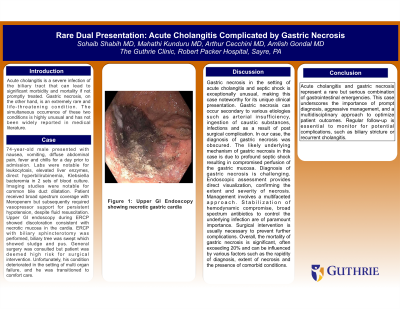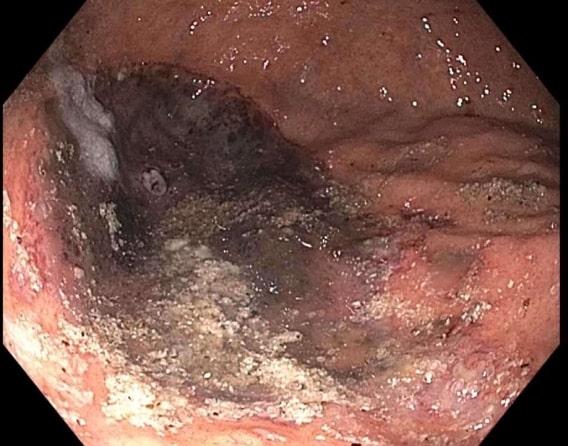Monday Poster Session
Category: Stomach
P3346 - Rare Dual Presentation: Acute Cholangitis Complicated by Gastric Necrosis
Monday, October 28, 2024
10:30 AM - 4:00 PM ET
Location: Exhibit Hall E

Has Audio
- SS
Sohaib Shabih, MD
Guthrie Robert Packer Hospital
Sayre, PA
Presenting Author(s)
Sohaib Shabih, MD, Mahathi Kunduru, MD, Arthur Cecchini, MD, Amlish Gondal, MD
Guthrie Robert Packer Hospital, Sayre, PA
Introduction: Acute cholangitis is a severe infection of the biliary tract that can lead to significant morbidity and mortality if not promptly treated. Gastric necrosis, on the other hand, is an extremely rare and life-threatening condition. The simultaneous occurrence of these two conditions is highly unusual and has not been widely reported in medical literature.
Case Description/Methods: 74-year-old male presented with nausea, vomiting, diffuse abdominal pain, fever and chills for a day prior to admission. Labs were notable for leukocytosis, elevated liver enzymes, direct hyperbilirubinemia, Klebsiella bacteremia in 2 sets of blood culture. Imaging studies were notable for common bile duct dilatation. Patient received broad spectrum coverage with Meropenem but subsequently required vasopressor support for persistent hypotension, despite fluid resuscitation. Upper GI endoscopy during ERCP showed discoloration consistent with necrotic mucosa in the cardia. ERCP with biliary sphincterotomy was performed, biliary tree was swept which showed sludge and pus. General surgery was consulted but patient was deemed high risk for surgical intervention. Unfortunately, his condition deteriorated in the setting of multi organ failure and escalating vasopressor requirements. He was eventually transitioned to comfort care measures.
Discussion: Gastric necrosis in the setting of acute cholangitis and septic shock is exceptionally unusual, making this case noteworthy for its unique clinical presentation. Gastric necrosis can occur secondary to various etiologies such as arterial insufficiency, ingestion of caustic substances, infections and as a result of post surgical complication.In our case, the diagnosis of gastric necrosis was obscured. The likely underlying mechanism of gastric necrosis in this case is due to profound septic shock resulting in compromised perfusion of the gastric mucosa.Diagnosis of gastric necrosis is challenging.Endoscopic assessment provides direct visualization, confirming the extent and severity of necrosis. Management involves a multifaceted approach. Stabilization of hemodynamic compromise, broad spectrum antibiotics to control the underlying infection are of paramount importance. Surgical intervention is usually necessary to prevent further complications. Overall, the mortality of gastric necrosis is significant, often exceeding 20% and can be influenced by various factors such as the rapidity of diagnosis, extent of necrosis and the presence of comorbid conditions

Disclosures:
Sohaib Shabih, MD, Mahathi Kunduru, MD, Arthur Cecchini, MD, Amlish Gondal, MD. P3346 - Rare Dual Presentation: Acute Cholangitis Complicated by Gastric Necrosis, ACG 2024 Annual Scientific Meeting Abstracts. Philadelphia, PA: American College of Gastroenterology.
Guthrie Robert Packer Hospital, Sayre, PA
Introduction: Acute cholangitis is a severe infection of the biliary tract that can lead to significant morbidity and mortality if not promptly treated. Gastric necrosis, on the other hand, is an extremely rare and life-threatening condition. The simultaneous occurrence of these two conditions is highly unusual and has not been widely reported in medical literature.
Case Description/Methods: 74-year-old male presented with nausea, vomiting, diffuse abdominal pain, fever and chills for a day prior to admission. Labs were notable for leukocytosis, elevated liver enzymes, direct hyperbilirubinemia, Klebsiella bacteremia in 2 sets of blood culture. Imaging studies were notable for common bile duct dilatation. Patient received broad spectrum coverage with Meropenem but subsequently required vasopressor support for persistent hypotension, despite fluid resuscitation. Upper GI endoscopy during ERCP showed discoloration consistent with necrotic mucosa in the cardia. ERCP with biliary sphincterotomy was performed, biliary tree was swept which showed sludge and pus. General surgery was consulted but patient was deemed high risk for surgical intervention. Unfortunately, his condition deteriorated in the setting of multi organ failure and escalating vasopressor requirements. He was eventually transitioned to comfort care measures.
Discussion: Gastric necrosis in the setting of acute cholangitis and septic shock is exceptionally unusual, making this case noteworthy for its unique clinical presentation. Gastric necrosis can occur secondary to various etiologies such as arterial insufficiency, ingestion of caustic substances, infections and as a result of post surgical complication.In our case, the diagnosis of gastric necrosis was obscured. The likely underlying mechanism of gastric necrosis in this case is due to profound septic shock resulting in compromised perfusion of the gastric mucosa.Diagnosis of gastric necrosis is challenging.Endoscopic assessment provides direct visualization, confirming the extent and severity of necrosis. Management involves a multifaceted approach. Stabilization of hemodynamic compromise, broad spectrum antibiotics to control the underlying infection are of paramount importance. Surgical intervention is usually necessary to prevent further complications. Overall, the mortality of gastric necrosis is significant, often exceeding 20% and can be influenced by various factors such as the rapidity of diagnosis, extent of necrosis and the presence of comorbid conditions

Figure: Gastric Cardia with necrotic mucosa
Disclosures:
Sohaib Shabih indicated no relevant financial relationships.
Mahathi Kunduru indicated no relevant financial relationships.
Arthur Cecchini indicated no relevant financial relationships.
Amlish Gondal indicated no relevant financial relationships.
Sohaib Shabih, MD, Mahathi Kunduru, MD, Arthur Cecchini, MD, Amlish Gondal, MD. P3346 - Rare Dual Presentation: Acute Cholangitis Complicated by Gastric Necrosis, ACG 2024 Annual Scientific Meeting Abstracts. Philadelphia, PA: American College of Gastroenterology.
